AMD’s New EPYC 7F52 Reviewed: The F is for ᴴᴵᴳᴴ Frequency
by Dr. Ian Cutress on April 14, 2020 9:45 AM EST- Posted in
- CPUs
- AMD
- Enterprise
- Enterprise CPUs
- EPYC
- SP3r2
- CPU Frequency
- Rome
- 7Fx2
CPU Performance: Rendering and Synthetics
For the rest of our CPU tests, we’re using a mix of rendering and synthetic workloads. This is slightly different to our previous server reviews, due to some adjustments, and we hope to be running something similar to our standard server workloads in the near future.
All CPUs are run with SMT/HT enabled.
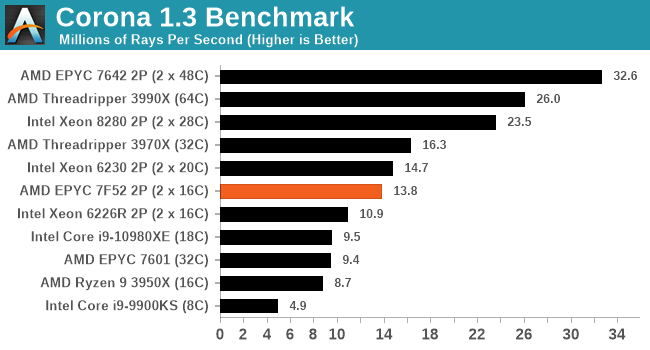
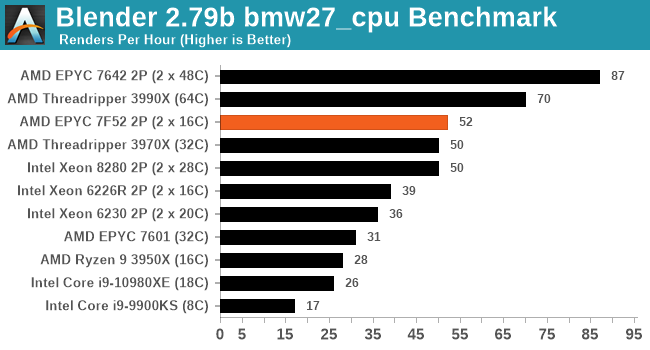
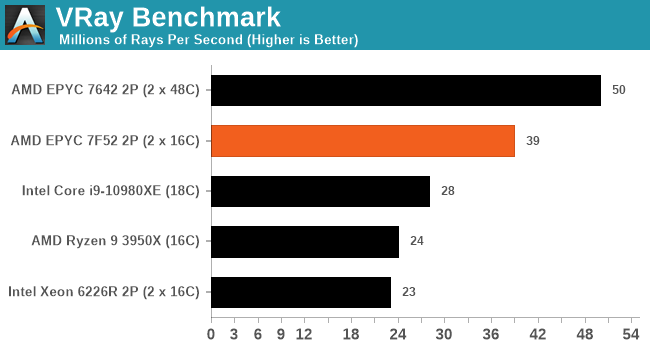
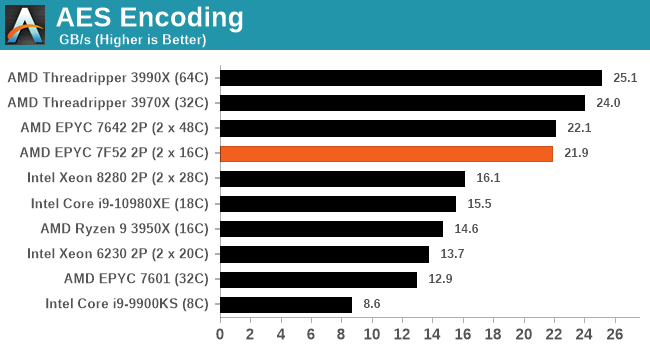
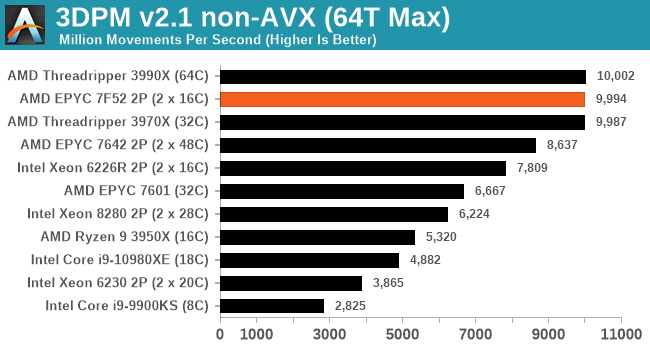
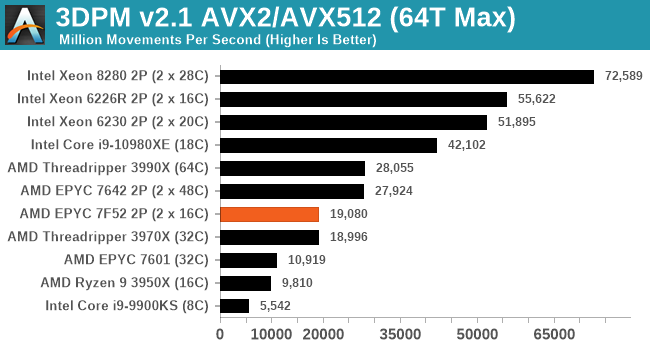
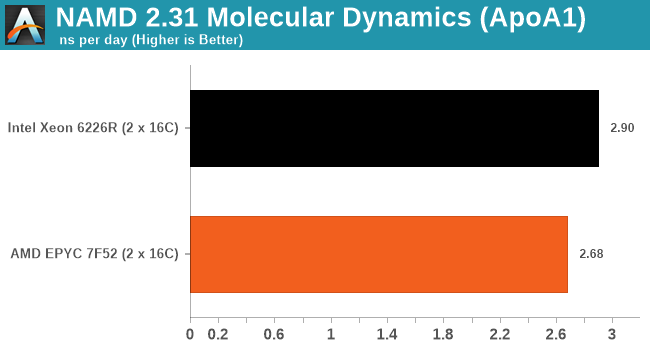

Even with the addition of a socket-to-socket in the mix, the dual 7F52 setup scores up to +100% in some benchmarks over the previous generation EPYC 7601. Against Intel’s latest 16-core Cascade Lake Refresh hardware, the AMD takes a sizeable lead in most benchmarks (except notably AVX512), which is perhaps to be expected given the price difference and power difference. What is interesting is how in certain workloads, the 2P 7F52 setup can make a reach up for the Xeon 8280s, despite the 8280s being 3x the cost each.










97 Comments
View All Comments
Santoval - Thursday, April 16, 2020 - link
"This cpu line is low margin and unable to seriously beat Intel big superiority in raw core performance."Zen 2 based servers CPUs already beat Intel in "raw core performance". This "F" series AMD introduced is not meant to beat Intel, since they already have. It is meant for certain customers who want fewer but faster cores/threads. Examples might be high-end workstations rather than servers (or workstations disguised as servers), which scale well up up to 16 - 24 cores and do not need CPUs with 32 - 64 cores which provide less performance per core as a trade-off.
As for the server market share AMD is going to exceed -or rather, *was* going to exceed, before Covid-19 froze everything -a 10% market share in Q2 2020 already (rather than a mere 5%). Source (in the 8th paragraph) :
https://www.forbes.com/sites/tiriasresearch/2020/0...
tyleeds - Thursday, April 16, 2020 - link
We used to custom order for customers what we called "The Oracle Special". Due to the way Oracle lays out their licensing on the database, you're looking for relatively low core counts, but screaming fast with a lot of cache. The price of Oracle licensing means you can safely say "power be damned" and just get the fastest core you can manage.This looks a lot like that...
Lord of the Bored - Monday, April 20, 2020 - link
"Intel on 14nm""AMD are late a lot"
You, sir, are a comedy genius!
schujj07 - Tuesday, April 14, 2020 - link
Yes the Intel counterpart is on 14nm and has a 205W TDP, but as we all know Intel's TDP is only measured off of base clock. During actual usage its TDP is much higher than 205W. This is why we see the Threadripper 3970X using less power than the 18 core Intel 10980XE even though the 10980 has a much lower TDP. https://www.servethehome.com/amd-ryzen-threadrippe... For here the 7F52 has higher performance than the 6246R and when you have workloads that are frequency sensitive that extra power doesn't matter as much.Deicidium369 - Tuesday, April 14, 2020 - link
Their server CPUs are a different thing than the desktop - You give people a little bit of info and all of a sudden they are freaking experts on power usage. So 205 is 205. NO ONE overclocks server CPUseek2121 - Tuesday, April 14, 2020 - link
It actually has little to do with overclocking on the Intel side. A stock Core i9 9900K will blow through it’s limit (both power and heat) with the vast majority of motherboards out there today.Their server CPUs, however, adhere to TDP.
schujj07 - Tuesday, April 14, 2020 - link
Not exactly true when there is a load. Max draw on dual 8280's is 685.1W for a 205W TDP. Due to the boost nature, the CPU will draw a lot more power. https://www.tomshardware.com/reviews/intel-cascade...Note the Epyc also draws more than its TDP as well and the review doesn't say whether this is total system or just CPU.
Oxford Guy - Saturday, April 18, 2020 - link
Reviewers or someone...There needs to be serious pressure to create a triple metric.
1. Maximum power the CPU can draw with a synthetic workload that maxes it as completely as possible.
2. Maximum power the CPU can draw with a real-world program (come up with an industry consensus).
3. For consumer CPUs: Maximum power the CPU can draw using the world's most demanding real-world gaming title. For prosumer and enterprise CPUs: Maximum power the CPU can draw with a second real-world program that is very different from the other one.
Stop enabling useless metrics that don't match reality.
bug77 - Tuesday, April 14, 2020 - link
And this is despite you having power measured on the second page of this review.schujj07 - Tuesday, April 14, 2020 - link
The chip on the 2nd page is the 6226R which will not compete with the 7F52. The competing chip from Intel is the 6246R.https://ark.intel.com/content/www/us/en/ark/produc... - 6226R
https://ark.intel.com/content/www/us/en/ark/produc... -6246R
The added 500MHz base clock brings the TDP from 150W to 205W.